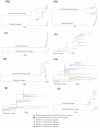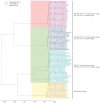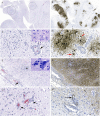Characterization of neurotropic HPAI H5N1 viruses with novel genome constellations and mammalian adaptive mutations in free-living mesocarnivores in Canada
- PMID: 36880345
- PMCID: PMC10026807
- DOI: 10.1080/22221751.2023.2186608
Characterization of neurotropic HPAI H5N1 viruses with novel genome constellations and mammalian adaptive mutations in free-living mesocarnivores in Canada
Abstract
The GsGd lineage (A/goose/Guangdong/1/1996) H5N1 virus was introduced to Canada in 2021/2022 through the Atlantic and East Asia-Australasia/Pacific flyways by migratory birds. This was followed by unprecedented outbreaks affecting domestic and wild birds, with spillover into other animals. Here, we report sporadic cases of H5N1 in 40 free-living mesocarnivore species such as red foxes, striped skunks, and mink in Canada. The clinical presentations of the disease in mesocarnivores were consistent with central nervous system infection. This was supported by the presence of microscopic lesions and the presence of abundant IAV antigen by immunohistochemistry. Some red foxes that survived clinical infection developed anti-H5N1 antibodies. Phylogenetically, the H5N1 viruses from the mesocarnivore species belonged to clade 2.3.4.4b and had four different genome constellation patterns. The first group of viruses had wholly Eurasian (EA) genome segments. The other three groups were reassortant viruses containing genome segments derived from both North American (NAm) and EA influenza A viruses. Almost 17 percent of the H5N1 viruses had mammalian adaptive mutations (E627 K, E627V and D701N) in the polymerase basic protein 2 (PB2) subunit of the RNA polymerase complex. Other mutations that may favour adaptation to mammalian hosts were also present in other internal gene segments. The detection of these critical mutations in a large number of mammals within short duration after virus introduction inevitably highlights the need for continually monitoring and assessing mammalian-origin H5N1 clade 2.3.4.4b viruses for adaptive mutations, which potentially can facilitate virus replication, horizontal transmission and posing pandemic risks for humans.
Keywords: Clade 2.3.4.4b; H5N1; HPAI; mammals; mutation; reassortment.
Conflict of interest statement
No potential conflict of interest was reported by the author(s).
Figures






Similar articles
-
Highly Pathogenic Avian Influenza H5N1 Virus Infections in Wild Red Foxes (Vulpes vulpes) Show Neurotropism and Adaptive Virus Mutations.Microbiol Spectr. 2023 Feb 14;11(1):e0286722. doi: 10.1128/spectrum.02867-22. Epub 2023 Jan 23. Microbiol Spectr. 2023. PMID: 36688676 Free PMC article.
-
Whole-genome sequence and genesis of an avian influenza virus H5N1 isolated from a healthy chicken in a live bird market in Indonesia: accumulation of mammalian adaptation markers in avian hosts.PeerJ. 2023 Feb 21;11:e14917. doi: 10.7717/peerj.14917. eCollection 2023. PeerJ. 2023. PMID: 36846456 Free PMC article.
-
Recurring Trans-Atlantic Incursion of Clade 2.3.4.4b H5N1 Viruses by Long Distance Migratory Birds from Northern Europe to Canada in 2022/2023.Viruses. 2023 Aug 30;15(9):1836. doi: 10.3390/v15091836. Viruses. 2023. PMID: 37766243 Free PMC article.
-
The genetics of highly pathogenic avian influenza viruses of subtype H5 in Germany, 2006-2020.Transbound Emerg Dis. 2021 May;68(3):1136-1150. doi: 10.1111/tbed.13843. Epub 2020 Sep 29. Transbound Emerg Dis. 2021. PMID: 32964686 Review.
-
H5N1 2.3.4.4b: a review of mammalian adaptations and risk of pandemic emergence.J Gen Virol. 2025 Jun;106(6):002109. doi: 10.1099/jgv.0.002109. J Gen Virol. 2025. PMID: 40465371 Free PMC article. Review.
Cited by
-
Highly pathogenic avian influenza H5N1 virus infections in pinnipeds and seabirds in Uruguay: Implications for bird-mammal transmission in South America.Virus Evol. 2024 Apr 13;10(1):veae031. doi: 10.1093/ve/veae031. eCollection 2024. Virus Evol. 2024. PMID: 38756986 Free PMC article.
-
Examining avian influenza virus exposure in seabirds of the northwest Atlantic in 2022 and 2023 via antibodies in eggs.Conserv Physiol. 2025 Feb 24;13(1):coaf010. doi: 10.1093/conphys/coaf010. eCollection 2025. Conserv Physiol. 2025. PMID: 40007734 Free PMC article.
-
Pathogenesis of bovine H5N1 clade 2.3.4.4b infection in macaques.Nature. 2025 Apr;640(8060):1017-1021. doi: 10.1038/s41586-025-08609-8. Epub 2025 Jan 15. Nature. 2025. PMID: 39814072
-
Descriptive Epidemiology and Phylodynamics of the "First Wave" of an Outbreak of Highly Pathogenic Avian Influenza (H5N1 Clade 2.3.4.4b) in British Columbia and the Yukon, Canada, April to September 2022.Transbound Emerg Dis. 2024 Feb 29;2024:2327939. doi: 10.1155/2024/2327939. eCollection 2024. Transbound Emerg Dis. 2024. PMID: 40303032 Free PMC article.
-
Phylogenetic Characterization of Novel Reassortant 2.3.4.4b H5N8 Highly Pathogenic Avian Influenza Viruses Isolated from Domestic Ducks in Egypt During the Winter Season 2021-2022.Viruses. 2024 Oct 23;16(11):1655. doi: 10.3390/v16111655. Viruses. 2024. PMID: 39599770 Free PMC article.
References
-
- Klenk HD, Rott R, Becht H.. On the structure of the influenza virus envelope. Virology. 1972;47:579–591. - PubMed
-
- Shaw ML, Palese P.. Orthomyxoviridae. In: Knipe D, Howley P, editor. Fields virology. Philadelphia, PA: Lippincott Williams & Wilkins; 2013. p. 1151–1185.
MeSH terms
LinkOut - more resources
Full Text Sources
Other Literature Sources
Medical
